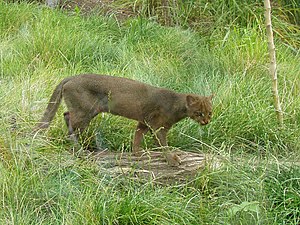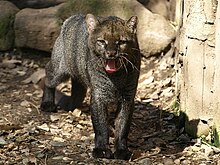Jaguarundi
| Jaguarundi | ||||||||||||
|---|---|---|---|---|---|---|---|---|---|---|---|---|

Jaguarundi, red morph |
||||||||||||
| Systematics | ||||||||||||
|
||||||||||||
| Scientific name | ||||||||||||
| Puma yagouaroundi | ||||||||||||
| ( E. Geoffroy Saint-Hilaire , 1803) |
The jaguarundi ( Puma yagouaroundi ), also known as the weasel cat , is a species of cat from southern North , Central and South America . It is remotely similar in shape to a marten . Despite its large distribution area and its relative abundance, the jaguarundi is one of the least explored cats on the American double continent.
features
Jaguarundis are short-legged, long-tailed cats. Their head body length is 65 cm, plus 45 cm tail. The body weight can be up to 9.1 kg. Overall, the Jaguarundi has a uniform coat color compared to other cats. There are two color variants: the gray morph has a gray coat, the red morph is red-brown; both variants have only a few, only slightly conspicuous white markings on the face. The gray morph can vary from ash gray to almost black. The reddish brown morph varies from light brown to olive brown to bright chestnut red. The morphs used to be thought of as different species and only the gray morphs were called jaguarundi, the red morphs as eyra. Both morphs occur together in the same distribution area and mate with each other without restriction, after which there are again red and gray cubs in their litter.
Jaguarundis' sound repertoire is very large and includes purring, growling, screaming and a bright chirp reminiscent of birds. A total of 13 clearly distinguishable vocalizations are described for Jaguarundis.
Distribution area and habitat
The jaguarundi is distributed over the tropics and subtropics of the American double continent. It occurs from the extreme south of the US state of Texas over the coastal plains of Mexico and Central America to Argentina and Bolivia . In Uruguay it has recently become extinct. It is very rare in Texas, the last known specimen was found in 1986 as a traffic victim. Its occurrence is occasionally reported for the southeast of Arizona, but there have been no confirmed sightings from this US state for a long time.
Jaguarundi sightings in Florida have been reported since the beginning of the 20th century. However, it can be assumed that the cats were introduced here. The introduction is attributed to a single person who imported the animals from South America and released them near Chiefland. The first sightings are reported from 1907. There were further sightings between 1930 and 1950. The first official report that the presence of Jaguarundis can be assumed was published in 1942. The number of sightings decreased significantly in the second half of the 20th century, but some are still reported.
The jaguarundi inhabits various habitats, but mainly sparse forests, scrubland and forest edges. It is less common in open terrain and in tropical rainforests. Basically, the jaguarundi seems to inhabit more open terrain than the sympatric cat species ocelot , long-tailed , northern and southern tiger . While Jaguarundis are occasionally seen in open grasslands, they generally prefer mosaic-like habitats with dense vegetation and open spaces. Telemetric studies in the 1980s have confirmed the previously anecdotal reports that jaguarundis prefer the proximity of running waters. Its height distribution ranges from sea level to altitudes of 3,200 meters.
Social and territorial behavior
While jaguarundis are most commonly observed individually, there have been numerous observations of two or more animals. It is not certain whether it is a couple, a female with almost fully grown young animals, or some other social unit. In the case of animals kept in captivity, it has been shown that Jaguarundi tolerate at least one communal keeping in the family group.
There is only a little data on the behavior of the territory, some of which are contradicting. In Belize, two males were observed using radio telemetry, roaming two very large areas of 88 and 100 square kilometers respectively. This would make the territories significantly larger than the male jaguars who live in the same region. The females' territory in Belize was only 20 square kilometers. In Mexico, the territories of both males and females were considerably smaller, equating to 8.9 square kilometers for the males and 8.3 for the females. Regardless of gender, the cats roamed their territory in Belize, covering an average of 6.6 kilometers a day. They did not return to their starting point.
Food and subsistence
Jaguarundis hunt both during the night and during the day, but the studies carried out on this species so far have shown that the jaguarundi is predominantly diurnal. In a study of this cat conducted in Belize , the jaguarundis began to take action just before dawn. Their activity phase extended without major interruptions until sunset, which started here at 6 p.m. The focus of hunting activities was at 11 a.m. Investigations in Mexico confirmed this finding: 85 percent of the Jaguarundi's activities took place during the day.
The jaguarundi is predominantly a ground hunter, even if it can climb skillfully and can safely balance on branches. You can jump up to two meters high, for example to strike at birds that fly up. They are also able to stand up on their hind legs using only their tails to support themselves.
The jaguarundi hunts rodents, rabbits, birds and reptiles. It is assumed that most of the prey animals weigh less than a kilogram. The few studies in Belize, Venezuela and Brazil support this view. In Belize, cotton rats were the most important prey, with birds and possums as important prey. Leaves and fruits were also found in these excrement examinations. In Venezuela, the stomach contents of twenty jaguarundis run over were examined. Here, too, the most important source of food was mammals, then birds and reptiles. Grass was also found in more than half of the stomachs. It is generally assumed that the jaguarundi is an opportunistic hunter, ie it mainly uses the prey animals that are common and that it can grab with comparatively easy. It also fits into this picture that jaguarundis have been observed eating fish caught in a drying pond.
Reproduction
It is not yet certain whether jaguarundis can produce offspring all year round, or whether there are two annual breeding seasons or (in the north of their range) one that falls in autumn. In captive animals, it has been found that the female's oestrus is only three to five days short and that the sexual cycle lasts about 53 days. Females ready to conceive show a change in behavior. They roll over the floor frequently and leave urine marks more often. The actual copulation ends with the typical cat neck bite .
The gestation period is 70 to 75 days. The litter can contain between one and four pups, two pups are the rule in captivity. The females first offer solid food to the young when the young are around three weeks old. The young animals initially only play with the food and chew on it. Usually the food brought in is eaten by the female. The young animals do not consume solid food until they are six weeks old.
Jaguarundis held in captivity have reached an age of more than ten years.
Systematics
The species was first described as Felis yagouaroundi by Étienne Geoffroy Saint-Hilaire . In addition to museum material in Paris, he was referring to the description of the “Yagouaroundi” by Félix de Azara in his Voyages dans l'Amerique Méridionale depuis 1781 jusqu'à 1801 , which had taken the name from the Indian inhabitants of Paraguay. The description as Felis yagouarondi 1809 by Bernard Germain Lacépède is taxonomically invalid (nomen invalidum). There are numerous other synonyms , including Felix eyra (also F. eira ), which refers to the red color form of the species also described by de Azara.
The systematic classification of the Jaguarundi is difficult. One of its special features is that, like the Old World cats, it has 38 chromosomes, while the other small South American cats have 36 chromosomes. Ingrid Weigel placed the species in the ( monotypical ) genus Herpailurus in 1961 , while many other authors put the puma in the genus of the same name . Molecular genetic studies from 2000 and 2006 confirmed the close relationship to the puma, but a study from 2010 did not reveal any closer relationship. So this question has not yet been finally clarified.
literature
- Don E. Wilson , DeeAnn M. Reeder (Eds.): Mammal Species of the World. A taxonomic and geographic Reference. Johns Hopkins University Press, Baltimore MD 2005, ISBN 0-8018-8221-4 .
- Mel Sunquist and Fiona Sunquist: Wild Cats of the World . The University of Chicago Press, Chicago 2002, ISBN 0-226-77999-8
Web links
- Species profile Jaguarundi; IUCN / SSC Cat Specialist Group in English
- Herpailurus yagouaroundi inthe IUCN Red List of Threatened Species 2012.2. Posted by: Caso, A., Lopez-Gonzalez, C., Payan, E., Eizirik, E., de Oliveira, T., Leite-Pitman, R., Kelly, M. & Valderrama, C., 2008. Retrieved April 20, 2013.
Single receipts
- ^ Sunquist, p. 114
- ↑ Jaguarundi (Felis yagouaroundi tolteca) (PDF; 41 kB) United States Fish and Wildlife Service . Retrieved January 1, 2009.
- ^ Sunquist, p. 114
- ^ Sunquist, p. 116
- ^ Sunquist, p. 114
- ^ Daniel Simberloff , Don C. Schmitz, and Tom C. Brown: Strangers in Paradise: Impact and Management of Nonindigenous Species in Florida . Island Press , 1997, ISBN 1559634308 , pp. 172-173 (accessed August 11, 2010).
- ^ Sunquist, p. 115
- ^ Sunquist, p. 115 and p. 116
- ^ Sunquist, p. 116
- ^ Sunquist, p. 115
- ^ Sunquist, p. 115
- ^ Sunquist, p. 115
- ^ Sunquist, p. 116
- ↑ AM Husson: The Mammals of Suriname. Zoological monographs from the Rijksmuseum van Natuurlijke Historie. Brill, Leiden, p. 323 ff.
- ↑ Don E. Wilso & DeeAnn M. Reeder: Mammal Species of the World: A Taxonomic and Geographic Reference. Vol. 12. JHU Press, 2005 Preview on Google Books
- ^ Sunquist, p. 114.
- ↑ M. Culver, Johnson, WE, Pecon-Slattery, J., O'Brein, SJ: Genomic Ancestry of the American Puma Archived from the original on June 16, 2007. Information: The archive link was automatically inserted and has not yet been checked. Please check the original and archive link according to the instructions and then remove this notice. (PDF) In: Oxford University Press (Ed.): Journal of Heredity . 91, No. 3, 2000, pp. 186-97. doi : 10.1093 / jhered / 91.3.186 . PMID 10833043 .
- ^ Warren E. Johnson, Eduardo Eizirik, Jill Pecon-Slattery, William J. Murphy, Agostinho Antunes, Emma Teeling, Stephen J. O'Brien: The Late Miocene Radiation of Modern Felidae: A Genetic Assessment. Science Vol. 311 (2006), pp. 73-77.
- ↑ Ingi Agnarsson, Matjaz Kuntner, Laura J. May-Collado: Dogs, cats, and kin: A molecular species-level phylogeny of Carnivora. Molecular Phylogenetics and Evolution 54 (2010), pp. 726-745. doi : 10.1016 / j.ympev.2009.10.033




